
The neon electron configuration, represented as [He] 2s2 2p6 or 1s2 2s2 2p6, showcases the simple arrangement of electrons within the atom. This configuration can be determined through various methods, including the aufbau principle, periodic table organization, Bohr model representation, or orbital diagram visualization.
Methods
Aufbau principle
- First, find electrons of neon atom
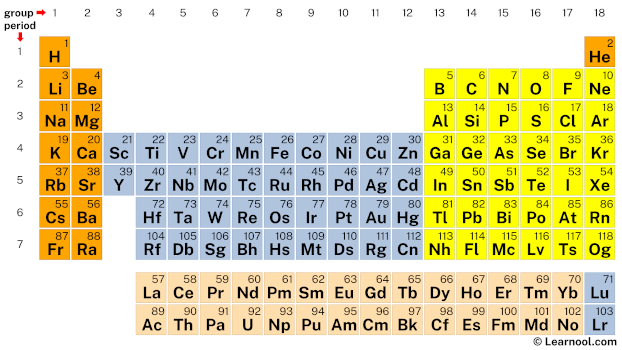
The atomic number of neon represents the total number of electrons of neon. Since the atomic number of neon is 10, the total electrons of neon are 10.
- Second, make a table of subshell and its maximum electrons
Calculate the maximum number of electrons each subshell can hold using the formula: 4ℓ + 2
Where, ℓ = azimuthal quantum number of the subshell
For s subshell, ℓ = 0
For p subshell, ℓ = 1
For d subshell, ℓ = 2
For f subshell, ℓ = 3
| subshell | max. electrons |
| s | 2 |
| p | 6 |
| d | 10 |
| f | 14 |
This means that,
Each s subshell can hold maximum 2 electrons
Each p subshell can hold maximum 6 electrons
Each d subshell can hold maximum 10 electrons
Each f subshell can hold maximum 14 electrons
- Finally, use aufbau chart and start writing electron configuration
Remember that we have a total of 10 electrons.
According to the aufbau principle, 1s subshell is filled first and then 2s, 2p, 3s… and so on.
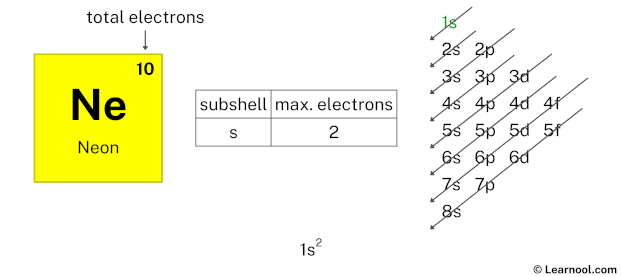
By looking at the chart, you can see that electrons are first filled in 1s subshell. Each s-subshell can hold a maximum of 2 electrons, so we will use 2 electrons for the 1s subshell.
So the electron configuration will be 1s2. Where, 1s2 indicates that the 1s subshell has 2 electrons.
Now we have used 2 electrons in the 1s subshell, so we have a total of 10 – 2 = 8 electrons left.

Looking at the chart, after 1s subshell now comes 2s subshell. Again, each s-subshell can hold a maximum of 2 electrons, so we will use 2 electrons for the 2s subshell.
So the electron configuration will be 1s2 2s2. Where, 2s2 indicates that the 2s subshell has 2 electrons.
Again, we have used 2 electrons in the 2s subshell, so we have a total of 8 – 2 = 6 electrons left.
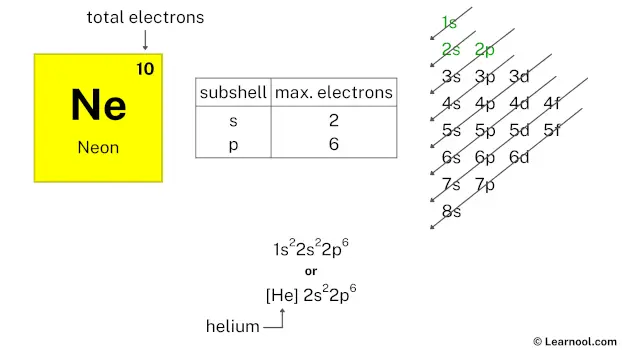
After 2s subshell now comes 2p subshell. Each p-subshell can hold a maximum of 6 electrons, and we also have 6 electrons left, so we will use that 6 electrons for the 2p subshell.
So the electron configuration will be 1s2 2s2 2p6. Where, 2p6 indicates that the 2p subshell has 6 electrons.
Therefore, the final electron configuration of neon is 1s2 2s2 2p6. And the condensed/abbreviated electron configuration of neon is [He] 2s2 2p6.
Where, He is helium
Periodic table
- First, get periodic table chart with spdf notation
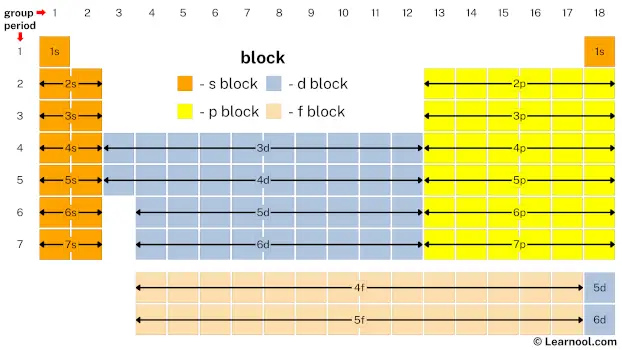
The above image shows periodic table blocks.
The ‘s’ in s block represents that all s block elements have their valence electrons in s subshell. Similarly, the ‘p’ in p block represents that all p block elements have their valence electrons in p subshell. And so on for d block and f block.
- Second, mark location of neon on periodic table
Neon is the p block element located in group 18 and period 2. Hence, mark the location of neon on the periodic table as follows:
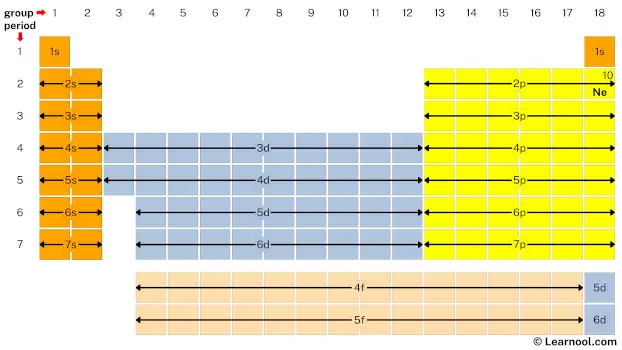
- Finally, start writing electron configuration
Remember that: each s subshell can hold maximum 2 electrons, each p subshell can hold maximum 6 electrons, each d subshell can hold maximum 10 electrons, and each f subshell can hold maximum 14 electrons.
Start writing electron configuration from the very first element (i.e., hydrogen) all the way up to neon.
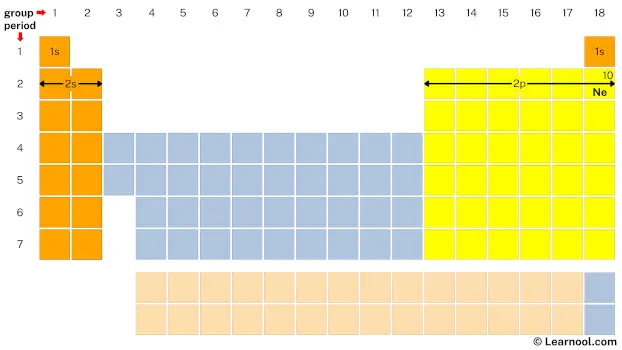
So the electron configuration of neon will be 1s2 2s2 2p6.
Bohr model
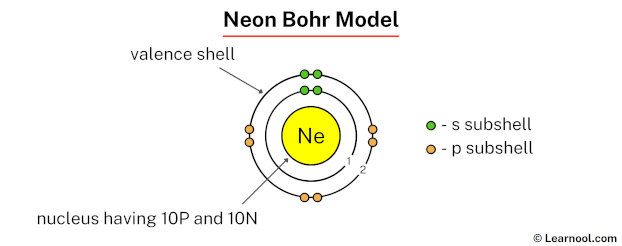
In the above image, 1 represents the 1st electron shell. Similarly, 2 represents the 2nd electron shell.
The 1st electron shell contains 1s subshell, and the 2nd electron shell contains 2s and 2p subshells.
We know that each s subshell can hold maximum 2 electrons, each p subshell can hold maximum 6 electrons, each d subshell can hold maximum 10 electrons, and each f subshell can hold maximum 14 electrons.
Also, we have to make sure that the electron configuration will match the order of aufbau principle (i.e., the 1s subshell is filled first and then 2s, 2p, 3s… and so on).
So the electron configuration of neon will be 1s2 2s2 2p6.
Where,
1s2 indicates that the 1s subshell has 2 electrons
2s2 indicates that the 2s subshell has 2 electrons
2p6 indicates that the 2p subshell has 6 electrons
Learn how to draw: Neon Bohr model
Orbital diagram
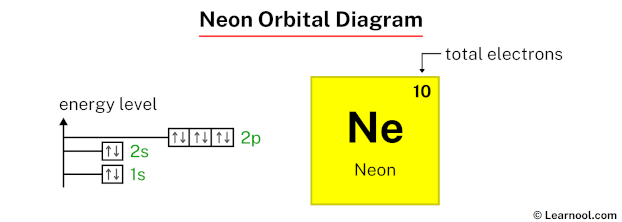
The above orbital diagram shows that the 1s subshell has 2 electrons, the 2s subshell has 2 electrons, and the 2p subshell has 6 electrons.
So the electron configuration of neon will be 1s2 2s2 2p6.
Learn how to draw: Neon orbital diagram
Next: Silicon electron configuration
Related
More topics
External links
- Electron Configuration for Neon (Ne) – The University of Maryland
- What is the electron configuration of the neon atom? – Socratic
- 1.1.8: Electron Configurations – Chemistry LibreTexts
- What is the electron configuration for neon? – Homework.Study.com
- What is the electron configuration of neon? Why is it different from the electron configuration of helium? – Quora
- Neon- electron configuration – Laurence Lavelle
- Neon Electron Configuration – Pinterest
- Q: What is the electron configuration of neon? – CK-12 Foundation
- Electron configuration – Wikipedia
- Neon – Element information, properties and uses | Periodic Table – Royal Society of Chemistry
- Neon » properties of free atoms – Mark Winter – University of Sheffield
- Electron Configurations – Florida State University
- 2022: ☢️ Electron Configuration of Neon (Ne) [Complete, Abbreviated, Uses … – Materials
- Which of these statements about the electron configurations of a neon atom, a sodium atom, and a sodium ion are true? – Brainly
- MCAT Physical : Electron Configuration – Varsity Tutors
- What is the electron arrangement for neon? – Answers
- Electron Configuration of the elements – Photographic Periodic Table
- Chemical Elements.com – Neon (Ne) – Chemical Elements.com
- Neon | The Periodic Table at KnowledgeDoor – KnowledgeDoor
- The ground-state electron configuration for Neon (Z=10) can be written as 1s22s22p6 – Chegg
- What is the electron configuration of neon (Ne)? – Quizlet
- Write the electron configuration for a neutral atom of neon – Numerade
Deep
Learnool.com was founded by Deep Rana, who is a mechanical engineer by profession and a blogger by passion. He has a good conceptual knowledge on different educational topics and he provides the same on this website. He loves to learn something new everyday and believes that the best utilization of free time is developing a new skill.
